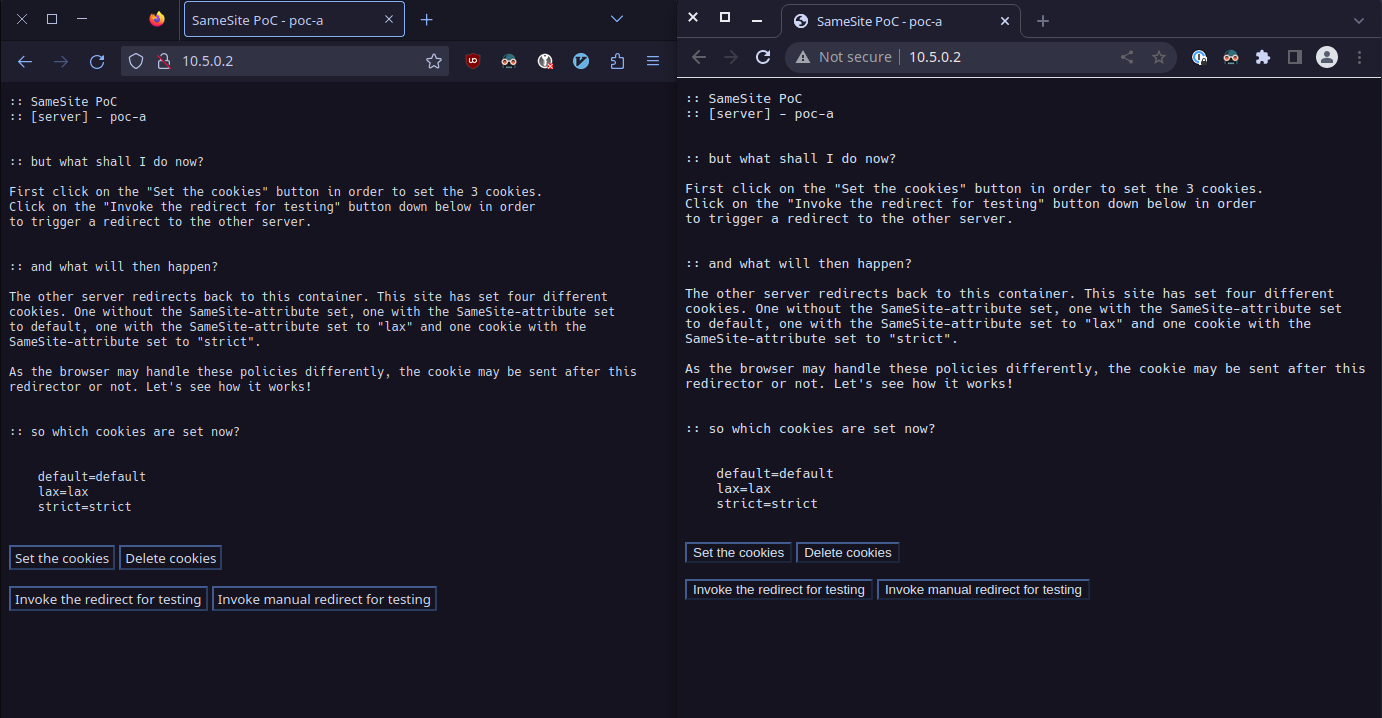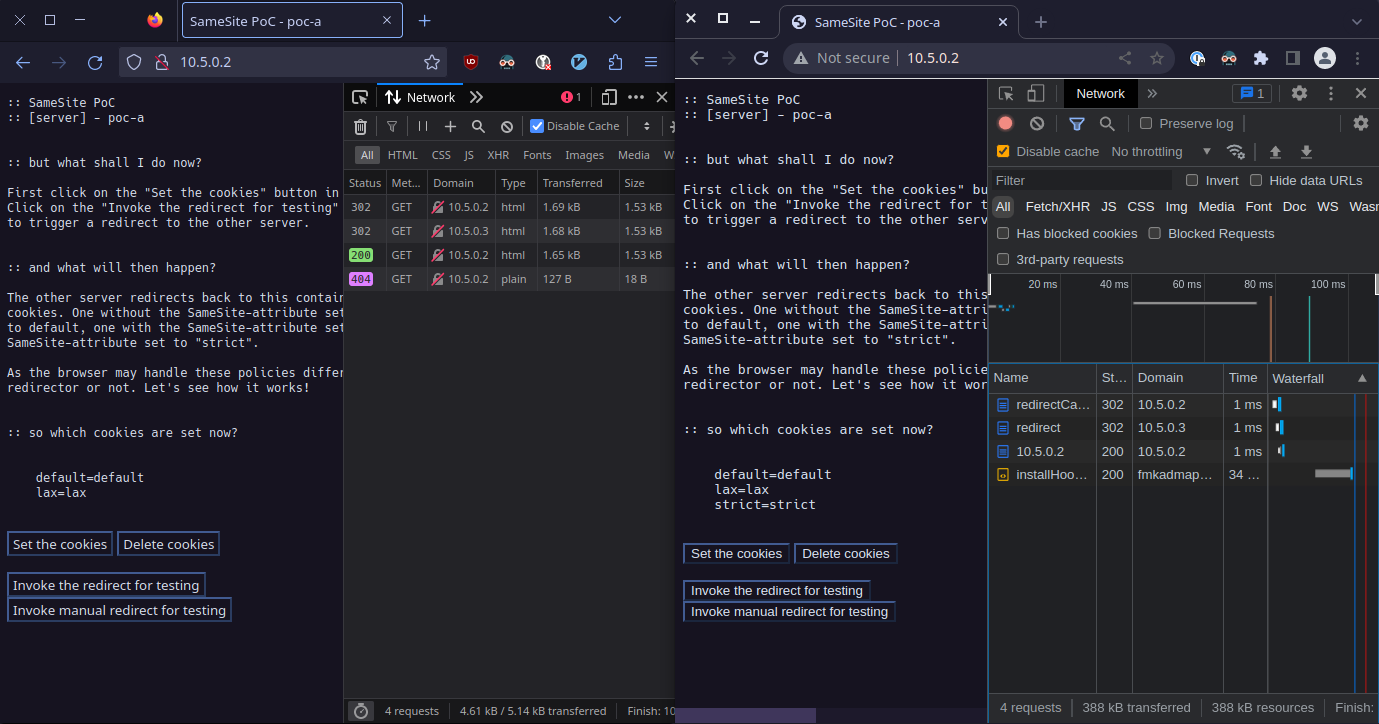SameSite cookies are commonly used to harden websites against CSRF attacks. These attacks can be mitigated in certain scenarios with SameSite cookies, since a cookie with the SameSite attribute set to strict should not be send to the destination site, if the request passed a foreign site. However, handling of the SameSite attribute differs between Firefox and Chromium.
What is the SameSite attribute in theory?
The SameSite attribute was specified in the RFC draft rfc6265bis. It can be used with three different enforcement modes RFC6265bis#section-5.5.7.1: none, strict and lax.
- none disables the SameSite enforcement such that cookies are also sent when the request is invoked by a cross site.
- strict enforces the cookie only to be sent when it is a same site request. Therefore the cookie is only sent, when the site was requested by entering the url manually in the url bar of the browser or navigating on the same domain.
- lax is not as strict as the strict mode since it allows to sent cookies in a request that is invoked by a cross site when it uses a safe http method. Http methods are considered safe if their semantic is defined as read-only (RFC7231#section-4.2.1).
In order to separate a same site request from a cross site request, the RFC introduces an algorithm in section 5.2. To conclude the algorithm, one can say, that every request, that is not initiated by hand(by entering the url manually) or by the exact match of the referring domain, is cross site. Every other request is a same site request.
Practical behavior in Firefox and Chromium
For testing the behavior of Firefox and Chromium I’ve implemented a website, that sets three cookies, is able to display them and is able to redirect manually, as well as automatically. Each of three cookies have the SameSite attribute set to none, lax and strict. The website is able to perform the role of both sites, since it is able to perform the redirect on both ways. Therefore the application will be started twice in a docker container with a static ip address: 10.5.0.2 and 10.5.0.3. This is important since it enforces another target address for the redirect.
After starting the docker container, we are able to open the first site in our first browser we are testing - Firefox 110.0.1 on linux. Then we click on “Set the cookies” in order to set all three cookies. As one can see in the screenshot, they are set correctly. Next to Firefox you are also able to see, that they are set in Chromium 111.0.5563.64 on linux.

Next we click on “Invoke manual redirect for testing” in both browsers. This will redirect the browser to 10.5.0.3. There we do not see any cookies, as we did not set them. If we then click on “Invoke manual redirect for testing” again, we are redirected back to 10.5.0.2 and are able to see only the cookies without the SameSite-attribute set to strict, which behaves exactly like the RFC described it before.

In our next test we will perform an automatic redirect. To reset the scenario, we click on “Delete cookies” and “Set the cookies”, which leads to the same page as in the first screenshot. After resetting the scenario, we click on “Invoke the redirect for testing”. This will automatically redirect to 10.5.0.3 and the back to 10.5.0.2. Hence the algorithm for determining a same site request states out that every URL in the redirect must be the same as the origin for a same site request, we expect to not see the cookie with the SameSite-attribute set to strict as well. However, Chromium is sending the cookie along with the request. Firefox, in contrast, is behaving correctly.

Potential attack surface
Some sites allow users to be redirected by a given URL as a query parameter, e.g. when you enter the URL to a restricted area without authentication and the destination URL is stored as a query parameter on the login page. If these redirects are used, even if they are bad practice, and allow redirects to external sites, cookies with SameSite set to strict will not mitigate CSRF attacks in Chromium.
In detail, an attacker would the an example URL to the victim like https://vuln.erable/login?to=https://att.acker. This would show the login site of the vulnerable site to the victim, who then enters the credentials. The vulnerable site then sends the cookie containing the session with SameSite set to strict back to the browser and invokes then the redirect to the attacking site via HTTP- or JS- redirect. The attacking site will then create some malicous redirect, which might extract some information or controls some aspects in the vulnerable site. This redirect is the performed by the browser. Firefox will drop the session cookie due to the SameSite attribute and will therefore break the session, such that the exploit would be mitigated in the first place. Chromium however will not drop the session cookie as shown in the lab setup before. Therefore the exploit would be successful.
Conclusion
Firefox and Chromium handle the SameSite attribute with enforcment mode strict quite different in terms of redirects. On automatic redirects, Chromium will not drop the cookie, in contrast to the specification. However, the potential attack surface is quite limited and requires bad practices and other flaws in the web application. Therefore one should be aware of the different behavior and not only rely on a single countermeasure against certain attacks. The mitigation should always be validated in certain scenarios.